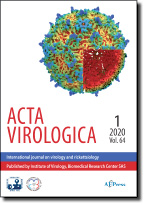Journal info
|
||
Select Journal
Journals
Bratislava Medical Journal Endocrine Regulations General Physiology and Biophysics Neoplasma Acta Virologica Current articles 2023 2022 2021 2020 2019 2018 2017 2016 2015 2014 2013 2012 2011 2010 2009 2008 2007 2006 2005 2004 2003 Studia Psychologica Cardiology Letters Psychológia a patopsych. dieťaťa Kovove Materialy-Metallic Materials Slovenská hudbaWebshop Cart
Your Cart is currently empty.
Info: Your browser does not accept cookies. To put products into your cart and purchase them you need to enable cookies.
Acta Virologica Vol.56, No.3, p.209-215, 2012 |
||
| Title: Genetic variety of bovine viral diarrhea virus 1 strains isolated from sheep and goats in India | ||
| Author: N. MISHRA, S. S. PITALE, K. RAJUKUMAR, A. PRAKASH, S. P. BEHERA, R. K. NEMA, S. C. DUBEY | ||
| Abstract: Antigenic and genetic typing of pestiviruses isolated from Indian sheep and goats was carried out. Testing of 1777 sheep and 1026 goat blood samples collected between 2004 and 2008 resulted in isolation of twelve pestiviruses, seven from sheep and five from goats. All of them were antigenically typed as bovine viral diarrhea virus 1 (BVDV-1). Both the partial 5ʹ-UTR and entire non-structural autoprotease (Npro) gene of the pestiviruses were amplified by RT-PCR and sequenced. The phylogenetic analysis confirmed all twelve sheep and goat pestiviruses as BVDV-1 and they were further classified into two subtypes, BVDV-1b (seven) and BVDV-1c (five). This is for the first time that BVDV-1c was detected in sheep and goats. However, no association between the subtype and geographic area of origin was observed. Although closely related, BVDV-1b and BVDV-1c isolates of sheep and goats were placed in a different clade than previously reported Indian BVDV-1b/BVDV-1c isolates. This study confirmed widespread prevalence of BVDV-1 in Indian sheep and goats that has significance in the epidemiology of bovine viral diarrhea. |
||
| Keywords: bovine viral diarrhea virus; BVDV-1; goat; Npro; genetic typing; sheep; 5ʹ-UTR | ||
| Year: 2012, Volume: 56, Issue: 3 | Page From: 209, Page To: 215 | |
| doi:10.4149/av_2012_03_209 |
||
|
Price:
14.00 €
|
||
|
|
||

